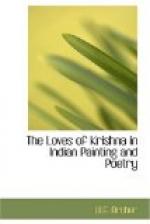Krishna then seats himself by a fig tree, lays his left leg across his right thigh, turns the sole of his foot outwards and assumes one of the postures in which abstraction is practised. As he meditates he appears lovelier than ever. His eyes flash. The four arms of Vishnu spring from his body. He wears his crown, his sacred thread and garland of flowers. As he sits, glorious and beautiful, the same hunter, who earlier had salvaged the iron spike from the fish, chances to pass by. His arrow is tipped with a piece of the iron and mistaking Krishna’s foot for part of a deer, he shoots his arrow and hits it. Approaching the mark, he sees Krishna’s four arms and is horrified to discover whom he has wounded. As he begs forgiveness, Krishna grants him liberation and dispatches him to heaven.
Daruka, Krishna’s charioteer, now comes in search of his master. Finding him wounded, he is overwhelmed with grief. Krishna tells him to go to Dwarka and inform the surviving Yadavas what has happened. On receiving the news they must leave Dwarka immediately, for the sea will shortly engulf it. They must also place themselves under Arjuna’s protection and go to Indraprastha. ’Then the illustrious Krishna having united himself with his own pure, spiritual, inexhaustible and universal spirit abandoned his mortal body.’[45]
Daruka goes mournfully to Dwarka where he breaks the news. Vasudeva with his two wives, Devaki and Rohini, die of grief. Arjuna recovers the bodies of Krishna and Balarama and places them on a funeral pyre. Rukmini along with Krishna’s seven other queens throw themselves on the flames. Balarama’s wives, as well as King Ugrasena, also die. Arjuna then appoints Krishna’s great grandson, Parikshit, to rule over the survivors and, after assembling the remaining women and children, removes them from Dwarka and travels slowly away. As they leave, the ocean comes up, swallowing the city and engulfing everything except the temple.
[Footnote 40: Plate 19.]
[Footnote 41: Note 13.]
[Footnote 42: Note 14.]
[Footnote 43: Note 7.]
[Footnote 44: Plate 1 and Note 7.]
[Footnote 45: Plate 2 and Note 7.]
(iv) The Purana Re-considered
Such an account gives us what the Mahabharata epic did not give—a detailed description of Krishna’s career. It confirms the epic’s view of Krishna as a hero and fills in many gaps concerning his life at Dwarka, his relations with the Pandavas, his life as a feudal prince and finally, his death. It makes clear that throughout the story Krishna is an incarnation of Vishnu and that his main reason for being born is to aid the good and kill demons. At the same time, it shows him in two important new lights—firstly, as one whose youth was spent among cowherds, in circumstances altogether different from those of a prince and secondly, as a delightful lover of women, who explores to the full the joys of




